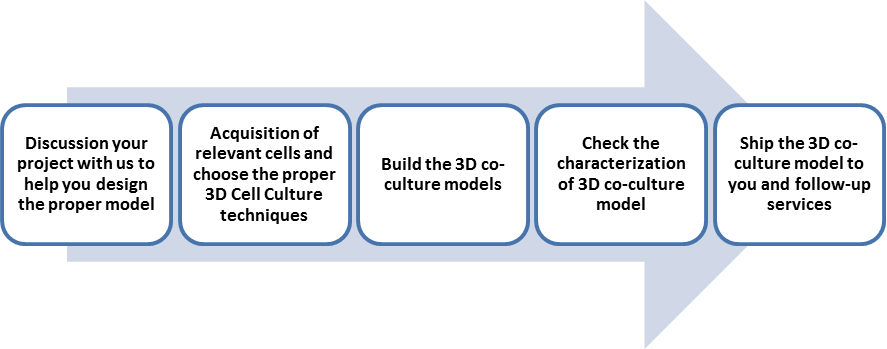- You are here: Home
- Services
- Cell Services
- 3D-Based Services
- 3D Co-culture Models Service
Services
-
Cell Services
- Cell Line Authentication
- Cell Surface Marker Validation Service
-
Cell Line Testing and Assays
- Toxicology Assay
- Drug-Resistant Cell Models
- Cell Viability Assays
- Cell Proliferation Assays
- Cell Migration Assays
- Soft Agar Colony Formation Assay Service
- SRB Assay
- Cell Apoptosis Assays
- Cell Cycle Assays
- Cell Angiogenesis Assays
- DNA/RNA Extraction
- Custom Cell & Tissue Lysate Service
- Cellular Phosphorylation Assays
- Stability Testing
- Sterility Testing
- Endotoxin Detection and Removal
- Phagocytosis Assays
- Cell-Based Screening and Profiling Services
- 3D-Based Services
- Custom Cell Services
- Cell-based LNP Evaluation
-
Stem Cell Research
- iPSC Generation
- iPSC Characterization
-
iPSC Differentiation
- Neural Stem Cells Differentiation Service from iPSC
- Astrocyte Differentiation Service from iPSC
- Retinal Pigment Epithelium (RPE) Differentiation Service from iPSC
- Cardiomyocyte Differentiation Service from iPSC
- T Cell, NK Cell Differentiation Service from iPSC
- Hepatocyte Differentiation Service from iPSC
- Beta Cell Differentiation Service from iPSC
- Brain Organoid Differentiation Service from iPSC
- Cardiac Organoid Differentiation Service from iPSC
- Kidney Organoid Differentiation Service from iPSC
- GABAnergic Neuron Differentiation Service from iPSC
- Undifferentiated iPSC Detection
- iPSC Gene Editing
- iPSC Expanding Service
- MSC Services
- Stem Cell Assay Development and Screening
- Cell Immortalization
-
ISH/FISH Services
- In Situ Hybridization (ISH) & RNAscope Service
- Fluorescent In Situ Hybridization
- FISH Probe Design, Synthesis and Testing Service
-
FISH Applications
- Multicolor FISH (M-FISH) Analysis
- Chromosome Analysis of ES and iPS Cells
- RNA FISH in Plant Service
- Mouse Model and PDX Analysis (FISH)
- Cell Transplantation Analysis (FISH)
- In Situ Detection of CAR-T Cells & Oncolytic Viruses
- CAR-T/CAR-NK Target Assessment Service (ISH)
- ImmunoFISH Analysis (FISH+IHC)
- Splice Variant Analysis (FISH)
- Telomere Length Analysis (Q-FISH)
- Telomere Length Analysis (qPCR assay)
- FISH Analysis of Microorganisms
- Neoplasms FISH Analysis
- CARD-FISH for Environmental Microorganisms (FISH)
- FISH Quality Control Services
- QuantiGene Plex Assay
- Circulating Tumor Cell (CTC) FISH
- mtRNA Analysis (FISH)
- In Situ Detection of Chemokines/Cytokines
- In Situ Detection of Virus
- Transgene Mapping (FISH)
- Transgene Mapping (Locus Amplification & Sequencing)
- Stable Cell Line Genetic Stability Testing
- Genetic Stability Testing (Locus Amplification & Sequencing + ddPCR)
- Clonality Analysis Service (FISH)
- Karyotyping (G-banded) Service
- Animal Chromosome Analysis (G-banded) Service
- I-FISH Service
- AAV Biodistribution Analysis (RNA ISH)
- Molecular Karyotyping (aCGH)
- Droplet Digital PCR (ddPCR) Service
- Digital ISH Image Quantification and Statistical Analysis
- SCE (Sister Chromatid Exchange) Analysis
- Biosample Services
- Histology Services
- Exosome Research Services
- In Vitro DMPK Services
-
In Vivo DMPK Services
- Pharmacokinetic and Toxicokinetic
- PK/PD Biomarker Analysis
- Bioavailability and Bioequivalence
- Bioanalytical Package
- Metabolite Profiling and Identification
- In Vivo Toxicity Study
- Mass Balance, Excretion and Expired Air Collection
- Administration Routes and Biofluid Sampling
- Quantitative Tissue Distribution
- Target Tissue Exposure
- In Vivo Blood-Brain-Barrier Assay
- Drug Toxicity Services
3D Co-culture Models Service

Cell cultures have played a significant role in the academy and pharmaceutical industry, but conventional 2D cultures fail to provide physiological relevance and communication network as compared to in vivo conditions, since they are unable to mimic the complexity of cellular microenvironment, an essential part for the cell behavior and systematic investigation. Using 2D cell culture systems can limit the predictive power of the cellular interactions. However, the 3D in vitro cultures provide a bridge between the conventional 2D cultures and in vivo studies. It was shown that in vitro 3D cultures recapture physiological cell-cell and cell-environment interactions (i.e., cellular morphology, cell differentiation, proliferation and gene expressions) with a greater relevant to animal and human studies, thus effectively facilitating the research progresses.
3D co-culture cell models now serve as important tools for solving scientific questions, which can be developed in different formats, depending on research goals and downstream usage. Co-culture cell models can emulate a variety of pathological conditions such as different stages of tumor invasion and metastasis, and identify of stromal components associated with pathological process.
Creative Bioarray 3D co-culture models service advantages
- Make your 3D co-culture models by using cells form our comprehensive human and animal cell bank or sending your own cells.
- Ready-to-use 3D cell cultures are highly functional and are amenable to high/live content imaging and a wide range of functional endpoint assays.
- Choose from numerous technologies (including scaffold-based and scaffold-free culture methods) to build your 3D co-culture models.
- Other 3D-based assays services are available at creative bioarray to fulfill your downstream research needs.
Workflow

Applications
Creative Bioarray provides services for co-culture tumor cells with other supportive stromal cells such as endothelial cells, fibroblast, immune cells and stem cells. Other 3D co-culture models are also available on request.
Study examples

Figure. Representative images for different types of breast cancer cells co-cultured with Fibroblasts
Quotations and ordering
Our customer service representatives are available 24hr a day!
References
- Jaganathan, H., et al. Three-dimensional in vitro co-culture model of breast tumor using magnetic levitation. Scientific reports. 2014, 4.
- Sawant, S., et al. Establishment of 3D Co-Culture Models from Different Stages of Human Tongue Tumorigenesis: Utility in Understanding Neoplastic Progression. PloS one. 2016, 11.8: e0160615.
- Jiang, Q., et al. a Novel 3D Culture Model to Mimic Hematopoietic Niche for HSCs Differentiating to Megakaryocyte with Deproteined and Degreased Human Bone or β-TCP. Blood. 2014, 124.21: 4360-4360.
Explore Other Options
For research use only. Not for any other purpose.

